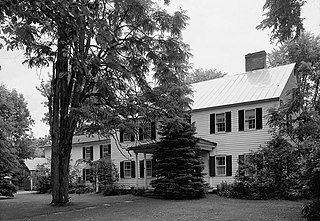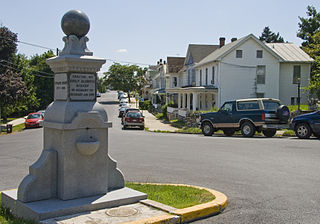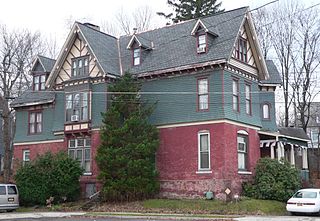
Martinsburg is a town in Lewis County, New York, United States. The population was 1,433 at the 2010 census. The town is named after its founding father, General Walter Martin.

The University of Charleston (UC) is a private non-profit university with its main campus in Charleston, West Virginia. The university also has a location in Beckley, West Virginia, known as UC-Beckley.

Prairie School is a late 19th- and early 20th-century architectural style, most common in the Midwestern United States. The style is usually marked by horizontal lines, flat or hipped roofs with broad overhanging eaves, windows grouped in horizontal bands, integration with the landscape, solid construction, craftsmanship, and discipline in the use of ornament. Horizontal lines were thought to evoke and relate to the wide, flat, treeless expanses of America's native prairie landscape.

The General Artemas Ward House is a historic house at 786 Main Street in Shrewsbury, Massachusetts. Commonly known as the "Artemas Ward House", it was the lifelong home of Artemas Ward, American Major General in the American Revolutionary War and a Congressman from Massachusetts. The house is listed on the National Register of Historic Places.

Martinsburg station is a railway station in Martinsburg, West Virginia, United States, served by MARC Brunswick Line commuter rail service and Amtrak Capitol Limited intercity rail service. The station has one side platform serving a siding track of the CSX Cumberland Subdivision, with a footbridge crossing the siding and the two main tracks to provide access to the preserved Baltimore and Ohio Railroad Martinsburg Shops complex.

The Gen. William Floyd House is a historic house on Main Street at Gifford Hill Road in Westernville, New York. Built in 1803, it was the last home of Founding Father William Floyd (1734–1821), a signer of the Declaration of Independence, and a driving force in the settlement of the area. It was declared a National Historic Landmark in 1971. The house is a private residence, and is not normally open to the public.

John Rudolph Niernsee was an American architect. He served as the head architect for the Baltimore and Ohio Railroad. Rudolph also largely contributed to the design and construction of the South Carolina State House located in Columbia, South Carolina. Along with his partner, James Crawford Neilson, Rudolph established the standard for professional design and construction of public works projects within Baltimore and across different states in the United States.
Walter Martin may refer to:

The Abell-Kilbourne House in Martinsburg, West Virginia is associated with John N. Abell, a prominent Martinsburg businessman and Charles W. Kilbourn, a Martinsburg mill owner. The former president of the Old National Bank, Abell developed the area known as "Abell's Addition" after his retirement in 1886. At that time Abell lived at 506 West Burke Street.

Aspen Hall, also known as the Edward Beeson House, was built beginning in 1771 as a stone house in the Georgian style in what would become Martinsburg, West Virginia. The first portion of the house was a 20 by 20 foot "fortified stone home", 2½ stories tall., in coursed rubble limestone built in 1745 by Edward Beeson I. It is the oldest house in Martinsburg.

The Boomtown Historic District comprises the western and southern portions of Martinsburg, West Virginia, generally along the alignments of West King Street and Winchester Avenue, following the general path of the town's electric streetcar system. It includes a former industrial section of the town, home to a number of textile mills, as well as the housing that was built for mill workers.

Gen. William A. Mills House is a historic home located at Mount Morris in Livingston County, New York. Constructed in 1838, the Mills Homestead was the last home of Gen. William Augustus Mills (1777–1844), who was the founder and first permanent white settler of Mount Morris. It is a 2+1⁄2-story brick dwelling combining both the Federal and Greek Revival styles. It is now headquarters of the Mount Morris Historical Society, which is responsible for the maintenance and restoration of the structure. The house is open as a historic house museum known as the Mills Mansion.

Gen. Edward F. Jones House is a historic home located at Binghamton in Broome County, New York. It was constructed in 1872 and is a large 2+1⁄2-story, irregularly shaped building built of an eclectic combination of materials and textures. It was part of a large estate assembled by General Edward F. Jones (1828–1913) by 1883. The foundation and first floor are constructed of brick while the upper stories are of wood with shingle, beaded board, and clapboard siding. It is an exceptional example of the Queen Anne style.

Methodist Episcopal Church of West Martinsburg, also known as West Martinsburg Methodist Church, is a historic Methodist Episcopal church located at West Martinsburg in Lewis County, New York. It dates to about 1840 and is of frame construction with clapboard siding. It is rectangular in plan with a simple gable roof. It features a two-stage bell tower surmounted by a steeple.

Martinsburg Town Hall, also known as First Lewis County Courthouse, is a historic town hall located at Martinsburg in Lewis County, New York. It was built in 1812 as Lewis County Courthouse and is the oldest public building in Lewis County. It is a 2+1⁄2-story, clapboard-sided, Georgian-inspired, Federal-period building with architecturally sensitive Victorian-period alterations. Italianate-style alterations were carried out in 1870 and included the pedimented projecting pavilion with palladian window. It was at this time the building was used as the Martin Institute; in the 1890s it became the town hall.

Gen. John G. Weaver House is a historic home located at Utica in Oneida County, New York. It was built about 1815 and is a massive 2-story, brick, hip roofed double pile building in the Federal style. It is composed of a 2-story, five-by-four-bay rectangular main block, with a 2-story, gable-roofed rear wing. It is believed that the home was designed by Philip Hooker or someone strongly influenced by his work.

Hays-Pitzer House is a historic home located near Martinsburg, Berkeley County, West Virginia. It is a two-story, five bay, Federal-style log and stone dwelling. The log section of the house was built in 1775 and the stone section was built about 1800.

Tuscarora Creek Historic District is a national historic district located near Martinsburg and Nollville, Berkeley County, West Virginia. It encompasses 31 contributing buildings and three contributing sites, related to the early settlement and economic development along the Tuscarora Creek. Notable buildings in the district include: Patterson's Mill (1765) and the miller's house, "Elm Dale," the Silber-Walters House, Huxley Hall, site of Patterson's New Mill and miller's house, Hibbard Mill, Tuscarora School, Providence Cemetery, the Mong House, Tuscarora Church (1802), James Noll Shop, Rumsey Mill site, and the poor house or "Mansion House" (1788).

South Water Street Historic District is a national historic district located at Martinsburg, Berkeley County, West Virginia. It encompasses 30 contributing buildings and one contributing site, related to residential, commercial, and economic development along the Tuscarora Creek. Notable buildings include: the Edison Electric Illumination Company of Martinsburg building; dwellings along South Water Street at 104–106, 108, 119, 120, 200, 202, 208, 216, and 308; rowhouses at 222, 224, and 226; the O'Hara-Martin House ; the Alburtis House; the South Water Street Stone House ; the Martinsburg Steam Laundry Company building; and Martinsburg Gas Company Complex. Also located in the district is the separately listed General Adam Stephen House.

The James Rumsey Monument, also known as Rumsey Monument Park, is a municipal park and former West Virginia state park in Shepherdstown, Jefferson County in the U.S. state of West Virginia. The park overlooks the Potomac River. It commemorates local inventor James Rumsey and his successful public demonstration of his steamboat invention on the Potomac in 1787. The monument consists of a 75 ft (23 m) column of Woodstock granite, which is capped with a globe and stands atop a tall, concrete plinth consisting of a 40 sq ft (3.7 m2) plaza.





















